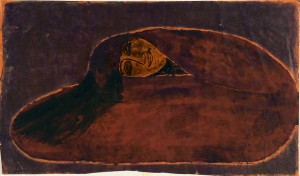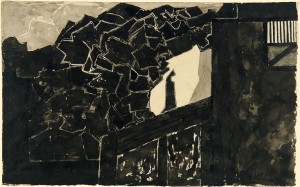Home / Discovery of Rhythm
Discovery of Rhythm
While Tagore’s memories and impressions of nature generated atmospheric landscapes, he also discovered the human body and its movement through his contemplation of natural scenes. Many of his works are populated with agile figures that seem to sometimes acrobatically morph into various forms found in nature.

Untitled (Seated Woman: forward bend), c. 1930-31
Colored ink and watercolor on paper
11 7/16 x 19 11/16 in. (29 x 50 cm)
Rabindra Bhavana, 00-1955-16
Contemplating the forms that appear in Tagore’s visual work, the pioneering art historian of South Asian art, Stella Kramrisch stated:
Tagore’s most powerful and original work relies on the two units of form, the drops and the angle. These linear, organizing elements are filled in his paintings with colour evoking a texture as if of a luminous body dappled with the darkness of its substantiality. In his monochrome work darker brush strokes over lighter ones create a similar effect.2

Untitled (Architectural setting with a silhouetted figure), 1929
Ink on paper
8 7/16 x 13 5/8 in. (21.4 x 34.6 cm)
Rabindra Bhavana, 00-2278-16
Tagore discovered those units of form through a life-long observation of nature and a deep empathy with it. They were expressed in his paintings as a gestalt of gestures that embodies a theatrical moment.
2. Stella Kramrisch, “Form Elements in the Visual Work of Rabindranath Tagore,” from Rabindranath Tagore: Collection of Essays, Ratan Parimoo, ed. (New Delhi: Lalit Kala Akademi, 1989), p. 12.

